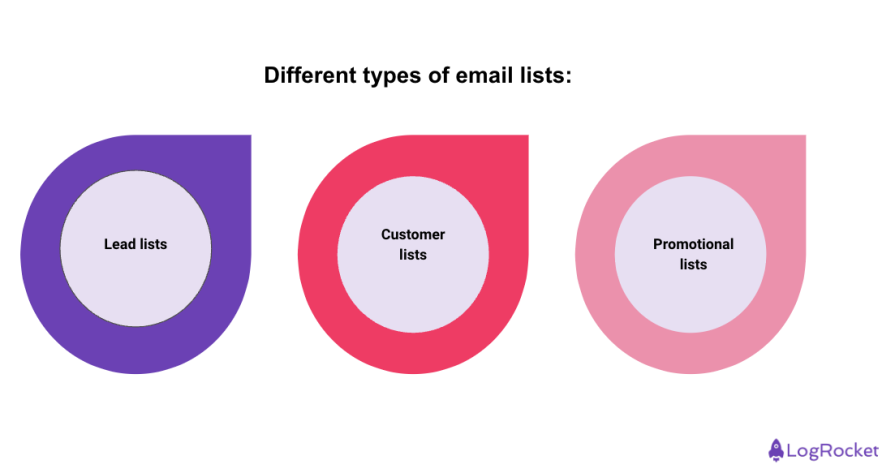In Poland, people tell a joke where a desperate guy prays in a church to turn his bad luck around and win the lottery. Suddenly the clouds open and the light of God shines onto the man and God says, “Son, help me out here, at least buy a lottery ticket.”

As someone trying to sell a digital product, these lottery tickets are your leads. Without working on securing leads, you cannot expect to win the lottery. Leads also require you to poke the customer multiple times before they go on to consider a purchase.
So how can you land leads in the first place? To help you get started, consider an email list. This article outlines what email lists are, their benefits, and strategies for building them.
An email list is a collection of email addresses that individuals or businesses use to send messages, newsletters, updates, and promotional materials to a group of people. These lists are mainly used for email marketing, allowing for targeted and personalized communication.
While in the past those lists were gigantic and full of random people, in the current age of privacy and data protection, only people who expressed the will to join an email list hold a spot there.
There are several types of email lists, each serving different purposes:

These contain potential customers who have already expressed interest in your products or services. You gather this list from a landing page or dedicated free webinars on a problem that your product or service can address.
Here, the list represents people who have already purchased from you. You can use them for sending targeted upsell messages, cross-selling offers, and building brand loyalty. This can be achieved with exclusive discounts and offers, as well as advertising new options and features in the product or service.
These are very similar to lead lists and contain people who have agreed to receive special offers and promotions. With such lists, you can drive additional sales and announce new products. Use these offering multiple different things to purchase, rather than a single product.
Promotional lists further divide into:
Each type of email list is curated to fit specific marketing strategies and target audiences, ensuring that the right messages reach the right people at the right time.
Email lists offer a direct line of communication to customers. Here are some of the biggest advantages:
Unfortunately, the average rate of promotional emails being opened hovers around 3 percent. Even if your subscribers are interested and well-matched, your emails might still be ignored due to the high number of such spam/promotional emails everyone receives. Still, it’s the oldest and most effective technique in the Internet marketing playbook.
Here are some tips and strategies to help you grow your email list:

Whatever your subscribers signed up for isn’t the end goal. If you don’t provide quality content through your emails, people will ignore you and unsubscribe. To reduce churn, fight to keep people signed up as much as you fought to gain them in the first place.
Offer a compelling lead magnet, such as a free ebook, webinar, or discount code, in exchange for email sign-ups. This incentive can significantly boost the number of subscribers. However, you risk having people sign up who only wanted the magnet, not the email, and thus, will make for very cold leads.
Remember to place email list sign-up forms strategically on your website. Ensure they’re visible without being intrusive. Good places include the header, footer, or as a pop-up just before the visitor leaves the site.
If you run successful social media accounts, use that to promote your email list. Share snippets of your email content and include a call-to-action (CTA) directing followers to sign up for more exclusive content:

A single social media post might not be enough. That said, through hard work and sharing content, you can foster relationships that encourage email subscriptions.
If you have a clear way to monetize your email list, you can implement a referral program that rewards current subscribers for bringing in new ones. This can create a viral effect, rapidly increasing your list size.
Managing an email list effectively helps you maintain healthy relationships with your subscribers and ensure the success of your email marketing campaigns. To accomplish this, try to implement as many of the following principles as possible:
By following these best practices, you can maintain a clean and engaged email list that supports your objectives while respecting your subscribers’ preferences and avoiding spam.
You probably hear people say that email lists can be a waste of time to build. Hopefully this article shows you that email lists can be an effective marketing tool if you invest proper time, and resources, provide quality to your subscribers, and build a good healthy relationship with them, both on a personal and technical level.
Until next time!
Featured image source: IconScout

LogRocket identifies friction points in the user experience so you can make informed decisions about product and design changes that must happen to hit your goals.
With LogRocket, you can understand the scope of the issues affecting your product and prioritize the changes that need to be made. LogRocket simplifies workflows by allowing Engineering, Product, UX, and Design teams to work from the same data as you, eliminating any confusion about what needs to be done.
Get your teams on the same page — try LogRocket today.

A practical guide for PMs who want to stop being bottlenecks, delegate smarter, and lead teams effectively with a clear ownership framework.

Stop letting unreliable data block features. Treat data as inventory to track quality, ownership, and ship with confidence.

Learn why slide decks slow teams down and explore better tools like whiteboards, PRDs, and prototypes to improve collaboration and alignment.

AI PM roles are evolving fast. Learn the five types of AI PMs, the skills they need, and how they shape AI products across industries.